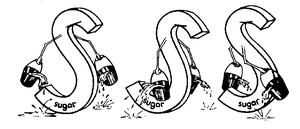
Polyuria: Glucose cannot leave the body by itself--it must take water with it. Losing too much water means the body tries replacing it and this causes thirst, or polydipsia. When too much water is lost through excess urination and the excess drinking cannot make up for it, dehydration can occur.
Polyuria [pah-lee-YOOR-ee-ah], abbreviated as PU, is excessive urination and may be a sign of diabetes. Proper treatment with insulin or in unusual cases, oral medications, restores proper metabolic function and eliminates the symptoms. Polyuria can also be a signal of other diseases or bodily problems[1][2][3], including urinary tract infections[4].
Polyuria in diabetes shows that the body is unable to metabolize carbohydrates properly. Carbohydrates are turned into glucose, which is sent into the blood to feed the cells. The cells, lacking insulin, don't accept the glucose, so it remains in the blood causing hyperglycemia. The extra glucose in the blood accumulates there until the kidneys see it as an impurity to be filtered out and discarded. This point is known as the renal threshold.
When the renal threshold is exceeded, and the excess glucose begins to spill into the urinary tract, the glucose makes the urine attract water in what's known as the osmotic effect. This extra water in the urine causes the excessive urination, dehydrating the body, which in turn causes the excessive drinking of polydipsia.
The blood, losing water, becomes more concentrated, leading to worse hyperglycemia and completing the vicious circle.
The over-frequent urination also takes with it electrolytes which the body needs to keep itself going--sodium (salt)[5] and potassium[6] among them. This contributes to lethargy and weakness, as the body is not able to keep itself in balance without the proper amounts of electrolytes[7]. Loss of sufficient electrolytes is why many pets and people need intravenous fluids when suffering from DKA; these elements need to be replenished after being so severely depleted.
Specific Gravity[]
The concentration (or lack of it) is determined by what's called a urine specific gravity test. The basis for comparison used is the specific gravity of water, which is 1.000.
|
If the specific gravity of a dog or cat's urine is less then 1.035, polydipsia is suspected[8]. | ||
|
Daily urine output for a cat or dog of more than 20 mililiters per pound of body weight means polyuria, or over-frequent urination[9]. | ||
More information on this is found at urination.
References[]
- ↑ Pet Education.com-Drs. Foster & smith-Frequent Urination
- ↑ Polyuria, Polydipsia & Diabetes Insipidus--WSAVA 2002-Nelson
- ↑ Vet Info4Dogs-Increased Drinking & Urinating
- ↑ Diabetes Mellitus-Petplace.com
- ↑ Pet Education.com-Drs. Foster & Smith-Sodium & Chloride Requirements 7 Deficiencies
- ↑ Pet Education.com-Drs. Foster & smith-Potassium Requirements & Deficiencies
- ↑ Long Beach Animal Hospital-Diabetes
- ↑ Polydipsia & Polyuria-Petplace.com
- ↑ Polydipsia & Polyuria-Petplace.com